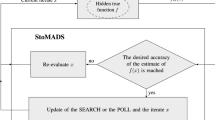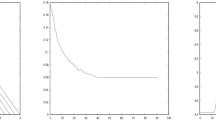Abstract
The class of Mesh Adaptive Direct Search (Mads) algorithms is designed for the optimization of constrained black-box problems. The purpose of this paper is to compare instantiations of Mads under different strategies to handle constraints. Intensive numerical tests are conducted from feasible and/or infeasible starting points on three real engineering applications.
The three instantiations are Gps, LTMads and OrthoMads. Constraints are handled by the extreme barrier, the progressive barrier, or by a mixture of both. The applications are the optimization of a styrene production process, a MDO mechanical engineering problem, and a well positioning problem, and the codes are publicly available.
Similar content being viewed by others
References
Abramson, M.A., Audet, C., Couture, G., Dennis, J.E. Jr., Le Digabel, S.: The nomad project. Software available at http://www.gerad.ca/nomad
Abramson, M.A., Audet, C., Dennis, J.E. Jr., Le Digabel, S.: OrthoMADS: A deterministic MADS instance with orthogonal directions. SIAM J. Optim. (2009, to appear)
Audet, C., Dennis, J.E. Jr.: Mesh adaptive direct search algorithms for constrained optimization. SIAM J. Optim. 17(1), 188–217 (2006)
Audet, C., Dennis, J.E. Jr.: A progressive barrier for derivative-free nonlinear programming. SIAM J. Optim. 20(4), 445–472 (2009)
Audet, C., Béchard, V., Le Digabel, S.: Nonsmooth optimization through mesh adaptive direct search and variable neighborhood search. J. Glob. Optim. 41(2), 299–318 (2008)
Booker, A.J., Dennis, J.E. Jr., Frank, P.D., Serafini, D.B., Torczon, V.: Optimization using surrogate objectives on a helicopter test example. In: Borggaard, J., Burns, J., Cliff, E., Schreck, S. (eds.) Optimal Design and Control, Progress in Systems and Control Theory, pp. 49–58. Birkhäuser, Cambridge (1998)
Booker, A.J., Dennis, J.E. Jr., Frank, P.D., Serafini, D.B., Torczon, V., Trosset, M.W.: A rigorous framework for optimization of expensive functions by surrogates. Struct. Optim. 17(1), 1–13 (1999)
Choi, T.D., Kelley, C.T.: Superlinear convergence and implicit filtering. SIAM J. Optim. 10(4), 1149–1162 (2000)
Conn, A.R., Scheinberg, K., Vicente, L.N.: Introduction to Derivative-Free Optimization. MPS/SIAM Book Series on Optimization. SIAM, Philadelphia (2009)
Fiacco, A.V., McCormick, G.P.: Nonlinear Programming: Sequential Unconstrained Minimization Techniques. Wiley, New York (1968). Reissued in 1990 by SIAM Publications, Philadelphia, as Vol. 4 in the series Classics in Applied Mathematics
Fletcher, R., Leyffer, S.: Nonlinear programming without a penalty function. Math. Program. Ser. A 91, 239–269 (2002)
Fletcher, R., Leyffer, S., Toint, Ph.L.: On the global convergence of a filter–SQP algorithm. SIAM J. Optim. 13(1), 44–59 (2002)
Fletcher, R., Leyffer, S., Toint, Ph.L.: A brief history of filter methods. SIAM SIAG/OPT Views-and-News 18(1), 2–12 (2006)
Fowler, K.R., Reese, J.P., Kees, C.E., Dennis, J.E. Jr., Kelley, C.T., Miller, C.T., Audet, C., Booker, A.J., Couture, G., Darwin, R.W., Farthing, M.W., Finkel, D.E., Gablonsky, J.M., Gray, G., Kolda, T.G.: Comparison of derivative-free optimization methods for groundwater supply and hydraulic capture community problems. Adv. Water Resour. 31(5), 743–757 (2008)
Gill, P.E., Murray, W., Saunders, M.A.: User’s guide for snopt version 7: Software for large-scale nonlinear programming (2006)
Halton, J.H.: On the efficiency of certain quasi-random sequences of points in evaluating multi-dimensional integrals. Numer. Math. 2(1), 84–90 (1960)
Marsden, A.L.: Aerodynamic noise control by optimal shape design. Ph.D. thesis, Stanford University (2004)
Perez, R., Liu, H.H.T., Behdinan, K.: Evaluation of multidisciplinary optimization approaches for aircraft conceptual design. In: AIAA/ISSMO Multidisciplinary Analysis and Optimization Conference, Albany, NY, September 2004
Sobieszczanski-Sobieski, J., Agte, J.S., Sandusky, R.R. Jr.: Bi-level integrated system synthesis (BLISS). Technical Report NASA/TM-1998-208715, NASA, Langley Research Center, August 1998
Torczon, V.: On the convergence of pattern search algorithms. SIAM J. Optim. 7, 1–25 (1997)
Waltz, R.A., Plantenga, T.D.: knitro user’s manual, version 6.0. Ziena optimization, inc. (2009)
Author information
Authors and Affiliations
Corresponding author
Additional information
Work of the first author was supported by Nserc grant 239436-05. The second author was supported by Lanl 94895-001-04 34, and the first two authors were supported by Afosr FA9550-07-1-0302, the Boeing Company and ExxonMobil Upstream Research Company.
Rights and permissions
About this article
Cite this article
Audet, C., Dennis, J.E. & Le Digabel, S. Globalization strategies for Mesh Adaptive Direct Search. Comput Optim Appl 46, 193–215 (2010). https://doi.org/10.1007/s10589-009-9266-1
Received:
Accepted:
Published:
Issue Date:
DOI: https://doi.org/10.1007/s10589-009-9266-1




